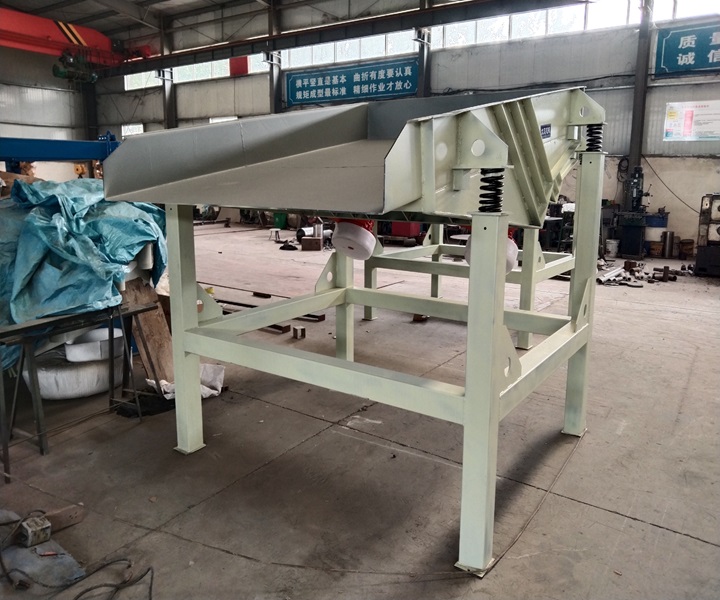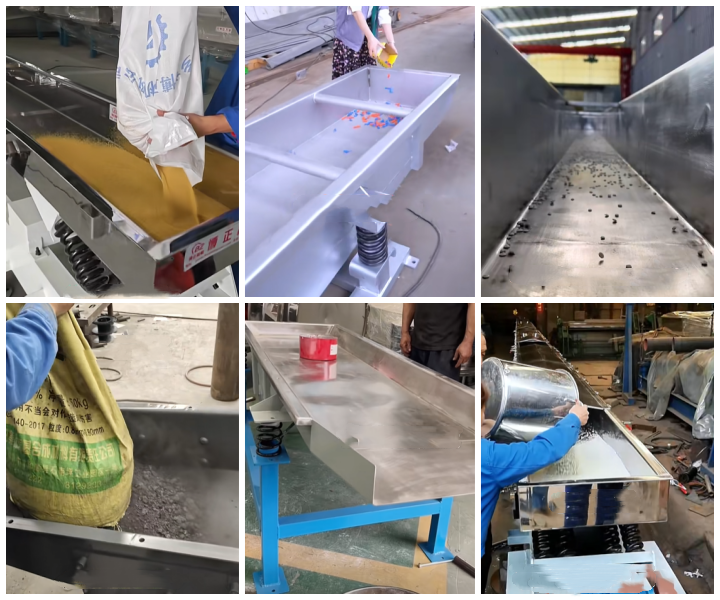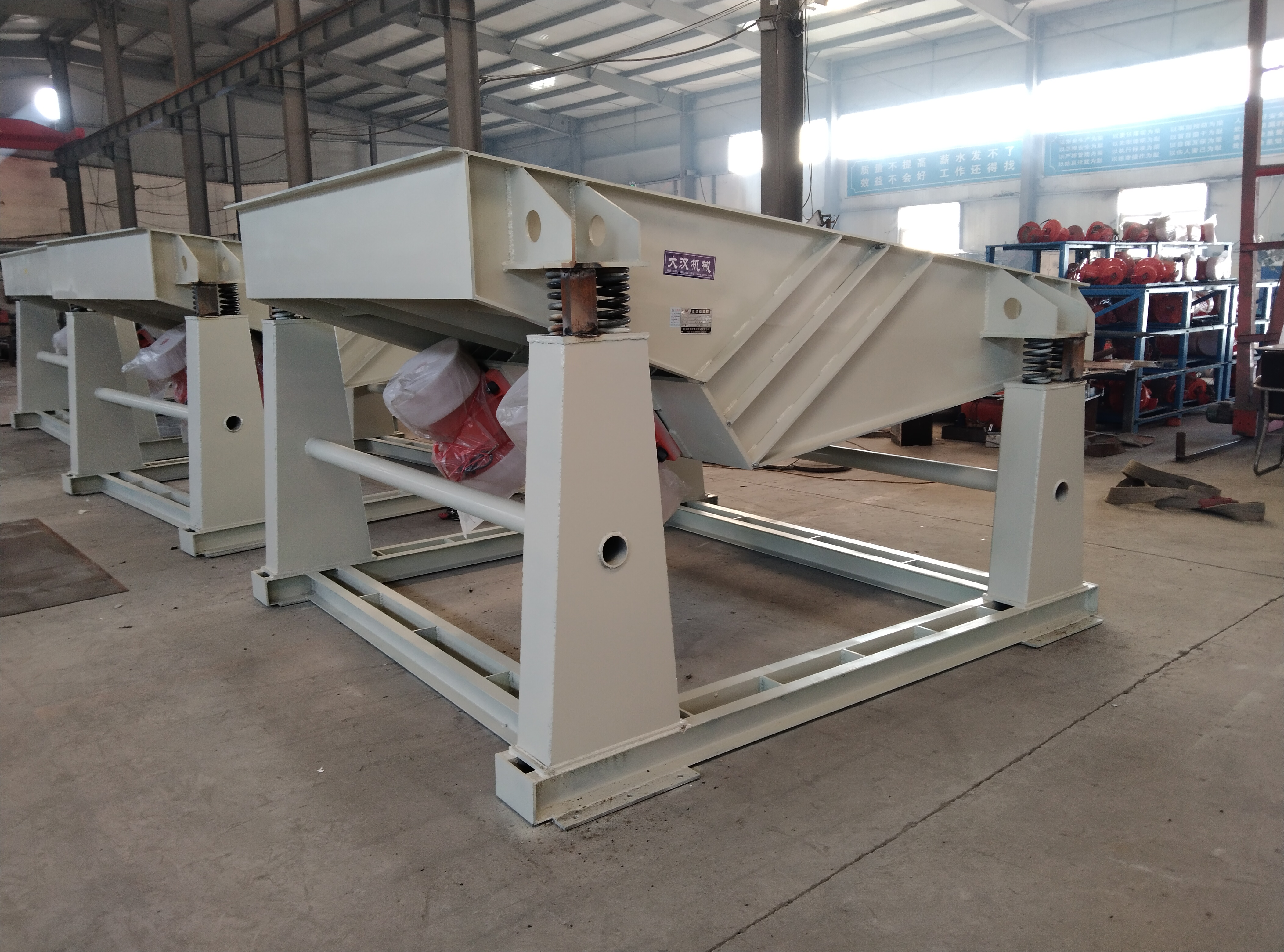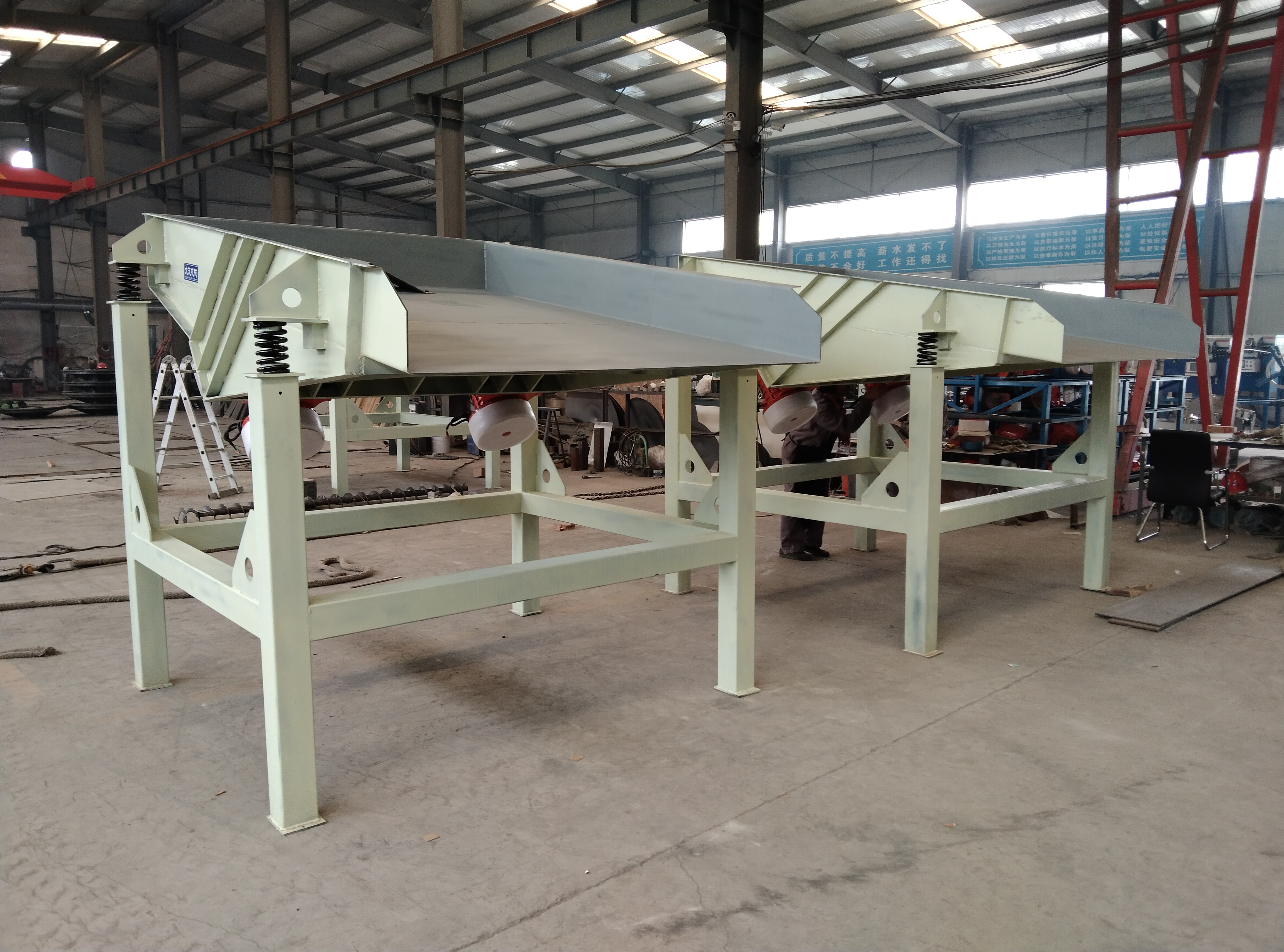
Whatsapp:+86 18339211009 Address: 1000 meters west of the gate of Yanjin County Forest Park, Xinxiang City, Henan Province.

Vibrating conveyors utilize vibration, using a flexible conveyor belt as a load-bearing element. A special vibration drive mechanism causes the conveyor trough or belt to reciprocate in a specific direction, thereby moving the material forward along the conveying direction.
Width: 400/500/650/600/800/1000/1200/1500 mm
Conveying speed: 1.25-2 m/s
Conveying length: 30 meters
Material: Carbon steel/Stainless steel
Conveying angle: 0°-60°
Application: Materials can be conveyed from the initial feed point to the discharge point at an angle or vertically, and are widely used in industries such as chemicals, electronics, and food processing.


Vibrating Conveyor uses vibration to transport materials along the belt. It uses a flexible conveyor belt as a load-bearing component and uses a special vibration drive device to make the conveyor belt vibrate at a high frequency and a small amplitude. This vibration can effectively reduce the friction resistance between the material and the conveyor belt, improve the conveying efficiency, and has a certain self-cleaning ability.
Vibrating conveyors are categorized by structure: open and closed. Open vibrating conveyors have an open trough and are suitable for conveying dry granules over short distances; closed vibrating conveyors are fully sealed and suitable for conveying dusty and toxic materials.

Open vibrating conveyors :have an open trough and no cover, offering a simple structure, low cost, and easy maintenance. They are suitable for conveying dry granular materials (such as grains and ores), applications requiring dust protection, and short distances of 10 meters or less. They are easy to observe and clean, have good heat dissipation, and are suitable for high-temperature materials.
Closed vibrating conveyor: It has a fully sealed structure and can be equipped with an exhaust port or inert gas protection. It is suitable for conveying dusty materials, toxic, volatile and flammable materials and long distances of ≥20 meters. It can prevent dust and pollution, reduce material loss, and is suitable for high-value products.
The vibrating conveyor has a simple and compact structure, low energy consumption and easy maintenance; it conveys smoothly with little damage to materials; and it is suitable for a variety of materials such as granules and powders.
Prevent material blockage: Vibration can make the material jump or slide slightly on the belt, which can effectively prevent material accumulation or blockage, and is particularly suitable for conveying materials with high viscosity or easy to agglomerate.
Protect material integrity: The vibration frequency and amplitude are adjustable, which can reduce the impact and wear on the material, and is particularly suitable for conveying fragile or brittle materials.
Uniform conveying: It can achieve uniform distribution and continuous conveying of materials, avoiding accumulation or faults of materials during conveying.
Adapt to a variety of materials: It can handle various types of materials, including granular, powdery, blocky, sticky materials, etc., with strong adaptability.
Easy to clean and maintain: The structure is simple, without complex transmission parts, easy to clean and maintain, reducing downtime and maintenance costs.
Can be linked with other equipment: It can be seamlessly connected with other equipment (such as screening machines, dryers, etc.) to achieve automated production.
Reduce material stratification: Through vibration, it can reduce the stratification of materials during transportation and ensure that the materials are evenly mixed.
| Model | Length | hight | Power |
| B500 | 3-10m | 1-4m | 0.75-1.1KW |
| B600 | 3-10m | 1-4m | 0.75-1.1KW |
| B800 | 4-10m | 1.5-4m |
1.1-2.2KW |
According to different structures and driving methods, vibrating conveyors can be divided into many types:

Linear vibrating conveyor: The conveying trough or conveyor belt mainly reciprocates in a straight line. This is the most common type.
Spiral vibrating conveyor: The conveying trough is spiral-shaped, and the material rises or falls along the spiral trajectory while vibrating. Commonly used for vertical or inclined transportation.
Electromagnetic vibrating conveyor: The excitation force is generated by an electromagnetic vibrator. It has a compact structure, low noise, and is easy to achieve stepless speed regulation and automatic control, but the conveying capacity is relatively small.
Hydraulic vibrating conveyor: The excitation force is generated by a hydraulic cylinder or hydraulic motor drive. The conveying capacity is large and the vibration parameters are adjustable, but the structure is complex and the cost is high.
Trough type vibrating conveyor: It uses a closed or semi-closed trough as a conveying component, which is suitable for conveying powder, granular and small block materials.
Tube type vibrating conveyor: It uses a closed tubular structure as a conveying component to achieve closed conveying, prevent dust flying and material pollution.
Belt type vibrating conveyor: It uses a flexible conveyor belt as a conveying component, supported by rollers and driven by a vibrating device. It is suitable for conveying bulk materials or finished items over a long distance.
A vibrating conveyor uses a vibrating motor or eccentric shaft to generate periodic excitation force, causing the trough to vibrate at high frequency and small amplitude in a fixed direction. Under the action of inertia and gravity, the material makes small jumps as the trough vibrates, moving forward in an inclined or horizontal direction. When the trough vibrates upward, the material escapes from the trough due to inertia; when the trough vibrates downward, the material falls back due to gravity and slides forward. The continuous vibration achieves the gradual conveying of materials.
The main structure of a vibrating conveyor includes a trough that carries the material, a vibrating motor that provides power, and support for the trough. Some conveyors also include auxiliary structures such as sealing covers, which work together to transport the material.

Conveyor belt: Usually a ring-shaped or open belt made of rubber, plastic or other special materials, used to carry and convey materials.
Driving device: Including motor, reducer and vibrator. The vibrator is the core component that generates vibration force. Common ones include eccentric block vibrator, cam vibrator, etc.
Support device: It is composed of rollers, frames, etc., used to support the conveyor belt and materials and ensure the normal operation of the conveyor belt. Unlike ordinary belt conveyors, the rollers of vibrating belt conveyors usually have a certain elasticity or special structure to adapt to the vibration of the conveyor belt.
Tensioning device: Used to adjust the tension of the conveyor belt, ensure the friction between the conveyor belt and the drive roller, and prevent slipping.
Vibrating conveyors, with their low wear and energy-saving features, have become an ideal choice for conveying granular and powdered materials in industries such as chemical, metallurgy, and food, helping companies achieve automated production!

Food industry: used to transport various food raw materials, semi-finished products and finished products, such as grains, candies, biscuits, etc. In the food production line, the vibrating belt conveyor can quickly and hygienically transport materials to various processing links.
Pharmaceutical industry: used to transport pharmaceutical granules, capsules, tablets, etc. in the process of drug production. Its precise conveying control and good hygienic performance can meet the strict quality requirements of the pharmaceutical industry for material transportation.
Chemical industry: suitable for conveying various chemical raw materials and products, such as fertilizers, plastic granules, pigments, etc. It can operate stably in harsh chemical production environments and has good adaptability to materials of different chemical properties.
Mining industry: can be used to transport ore, coal and other materials. In the process of mining and processing, the vibrating belt conveyor can efficiently transport the mined ore to subsequent processes such as ore dressing and crushing, thereby improving the production efficiency of the mine.
Building materials industry: used to transport building materials such as cement, sand, gravel, bricks, etc. Its strong conveying capacity and adaptability to heavy-loaded materials play an important role in building materials production and construction.
As a conveying manufacturer, we have customers in different industries who use it widely. The following four cases show the wide application of vibrating belt conveyors in the food, chemical, mining and pharmaceutical industries.

A flour mill needs to transport flour from the production line to the packaging plant. However, due to the high dust content and fluidity of flour, traditional conveying equipment can easily cause dust pollution and material waste. A vibrating conveyor belt with an enclosed design effectively prevents dust generation.
A chemical raw material company needs to transport granular chemical raw materials. However, due to the high agglomeration and corrosive nature of these raw materials, traditional conveying equipment is prone to clogging and severe wear. A vibrating conveyor belt made of corrosion-resistant material is selected. The vibration function prevents material caking and ensures continuous and uniform transport.
A mining company needs to transport crushed ore from the crusher to the screening equipment. However, due to the varying particle sizes and impurities in the ore, traditional conveying equipment is prone to clogging. A heavy-duty vibrating conveyor is used. The vibration function effectively prevents clogging with large ore particles and can accommodate inclined transport.
A pharmaceutical company needs to transport powder from the mixing equipment to the packaging line. However, due to the extremely high hygiene requirements for powder and the need to maintain material integrity, traditional conveying equipment is insufficient. A vibrating belt conveyor made of food-grade stainless steel with an enclosed design and adjustable vibration function ensures that the powder is not contaminated or damaged during transportation.
Choosing a suitable vibrating conveyor is a complex process that requires comprehensive consideration of multiple factors such as material characteristics, conveying requirements, working environment, and economy. The following are the main factors to be considered when selecting and designing a vibrating conveyor in detail:

Material type: Different materials (such as granular, powdery, lumpy, sticky materials, etc.) have different requirements for vibrating conveyors.
Particle size: The particle size of the material affects the design and vibration parameters of the conveyor.
Shape: The shape of the material (such as round, flake, fibrous, etc.) will affect the conveying effect.
Density: The density of the material determines the carrying capacity and vibration intensity of the conveyor.
Humidity: Materials with too high humidity may cause adhesion or agglomeration, requiring special design.
Viscosity: Viscous materials tend to adhere to the conveyor trough, so it is necessary to select anti-sticking materials or increase the vibration intensity.
Temperature: High-temperature materials require high-temperature resistant materials or cooling devices.
Conveying distance: The length of the conveying distance affects the design and power configuration of the conveyor. Long-distance conveying may require segmented design or increased power.
Horizontal conveying: Suitable for most scenarios, the design is relatively simple.

Inclined conveying: It is necessary to select appropriate vibration parameters according to the fluidity and inclination angle of the material.
Vertical conveying: Suitable for occasions with limited space, but the design is complex, and it is necessary to ensure that the vibration intensity is sufficient.
Dust concentration: High dust environment requires a closed design to prevent dust leakage.
Corrosiveness: Corrosion-resistant materials (such as stainless steel) need to be selected in corrosive environments.
Explosion-proof requirements: Explosion-proof vibration motors need to be selected in flammable and explosive environments.
Dahan Vibration Machinery Co., Ltd. has been focusing on the research and development and manufacturing of vibrating conveyors for more than 10 years, providing open/closed vibrating conveyors from 1 to 200t/h. The products are made of carbon steel/stainless steel and support customized designs such as explosion-proof and high-temperature resistant. It has served many customers and exported overseas. With its technological advantage of 30% energy saving, it continues to provide high-speed conveying solutions for the chemical, food, metallurgical and other industries.

Vibrating belt conveyors have become an indispensable material conveying equipment in modern industrial production with their unique working principle, reasonable structural design, significant advantages and wide application fields. With the continuous advancement of science and technology and the growing demand for industrial production, vibrating belt conveyors will continue to innovate and develop, providing more reliable support for efficient production in various industries.
NOTE: You can also send a message to us by this email sale@xxdahan.com, we will reply to you within 24 hours. Now tell us your needs, there will be more favorable prices!